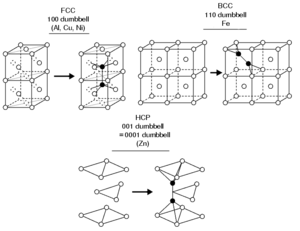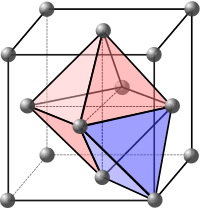Interstitial defect
Interstitials are a variety of crystallographic defects, i.e. atoms which occupy a site in the crystal structure at which there is usually not an atom, or two or more atoms sharing one or more lattice sites such that the number of atoms is larger than the number of lattice sites. They are generally high energy configurations. [1] Small atoms in some crystals can occupy interstitial sites in an energetically favourable configuration, such as hydrogen in palladium. Interstitials can be produced for instance by particle irradiation above the threshold displacement energy, but may also exist in small concentrations in thermodynamic equilibrium.
Self-interstitials
Self-interstitial defects are interstitial defects which contain only atoms which are the same as those already present in the lattice.

The structure of interstitial defects has been experimentally determined in some metals and semiconductors.
Contrary to what one might intuitively expect, most self-interstitials in metals with a known structure have a 'split' structure, in which two atoms share the same lattice site. [1][2] Typically the center of mass of the two atoms is at the lattice site, and they are displaced symmetrically from it along one of the principal lattice directions. For instance, in several common FCC metals such as copper, nickel and platinum, the ground state structure of the self-interstitial is the split [100] interstitial structure, where two atoms are displaced in a positive and negative [100] direction from the lattice site. In BCC iron the ground state interstitial structure is similarly a [110] split interstitial.
These split interstitials are often called dumbbell interstitials, because plotting the two atoms forming the interstitial with two large spheres and a thick line joining them makes the structure resemble a dumbbell weight-lifting device.
In other BCC metals than iron, the ground state structure is believed based on recent Density-functional theory calculations to be the [111] crowdion interstitial,[3] which can be understood as a long chain (typically some 10-20) of atoms along the [111] lattice direction, compressed compared to the perfect lattice such that the chain contains one extra atom.
In semiconductors the situation is more complex, since defects may be charged and different charge states may have different structures. For instance, in silicon, the interstitial may either have a split [110] structure or a tetrahedral truly interstitial one. [4]
Impurity interstitials
Small impurity interstitial atoms are usually on true off-lattice sites between the lattice atoms. Such sites can be characterized by the symmetry of the interstitial atom position with respect to its nearest lattice atoms. For instance, an impurity atom I with 4 nearest lattice atom A neighbours (at equal distances) in a FCC lattice is in a tetrahedral symmetry position, and thus can be called a tetrahedral interstitial.
Large impurity interstitials can also be in split interstitial configurations together with a lattice atom, similar to those of the self-interstitial atom.

Effects of interstitials
Interstitials modify the physical and chemical properties of materials.
- Interstitial carbon atoms have a crucial role for the properties and processing of steels, in particular carbon steels.
- Impurity interstitials can be used e.g. for storage of hydrogen in metals.
- The amorphization of semiconductors such as silicon during ion irradiation is often explained by the buildup of a high concentration of interstitials leading eventually to the collapse of the lattice as it becomes unstable [5][6]
- Creation of large amounts of interstitials in a solid can lead to a significant energy buildup, which on release can even lead to severe accidents in certain old types of nuclear reactors (Wigner effect). The high-energy states can be released by annealing.
- At least in face-centered cubic (FCC) lattice, interstitials have a large diaelastic softening effect on the material [7]
- It has been proposed that interstitials are related to the onset of melting and the glass transition.[8][9][10]
References
- ↑ 1.0 1.1 P. Ehrhart, Properties and interactions of atomic defects in metals and alloys, edited by H. Ullmaier, Landolt-Börnstein, New Series III vol. 25 ch. 2 p. 88- (Springer, Berlin, 1991)
- ↑ Self-interstitial atoms in metals, Journal of Nuclear Materials 69&70 (1978) p. 465.
- ↑ Derlet, P. M.; D. Nguyen-Manh; S. L. Dudarev (2007). "Multiscale modeling of crowdion and vacancy defects in body-centered-cubic transition metals". Phys. Rev. B 76: 054107. doi:10.1103/physrevb.76.054107.
- ↑ G. D. Watkins, Native defects and their interactions with impurities in silicon, in Defects and Diffusion in Silicon Processing, edited by T. Diaz de la Rubia, S. Coffa, P. A. Stolk and C. S. Rafferty, MRS Symposium Proceedings vol. 469 p. 139 (Materials Research Society, Pittsburg 1991)
- ↑ D. N. Seidman, R. S. Averback, P. R. Okamoto, and A. C. Baily, Amorphization Processes in Electron- and/or Ion-Irradiated Silicon, Phys. Rev. Lett. 58, 900 (1987)
- ↑ G. F. Cerofilini, L. Meda, and C. Volpones, A model for damage release in ion-implanted silicon, J. Appl. Phys. 63, 4911 (1988)
- ↑ L. E. Rehn, J. Holder, A. V. Granato, R. R. Coltman, and J. F. W. Young, Effects of thermal-neutron irradiation on the elastic constants of copper, Phys. Rev. B 10, 349 (1974)
- ↑ A/.////.JHFVJHVJ. V. Granato, Interstitialcy Model for Condensed Matter States of Face-Centered-Cubic Metals, Phys. Rev. Lett. 68, 974 (1992)
- ↑ M. Forsblom and G. Grimvall, Homogeneous melting of superheated crystals: Molecular dynamics simulations, Phys. Rev. B 72, 054107 (2005)
- ↑ K. Nordlund, Y. Ashkenazy, R. S. Averback, and A. V. Granato, Strings and interstitials in liquids, glasses and crystals, Europhys. Lett. 71, 625 (2005)